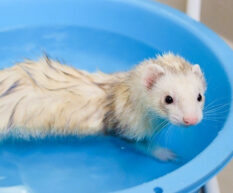Ferret News
Keeping the Peace in a Multi-Ferret Household
By Jazmin "Sunny" Murphy

Ferret owners commonly raise more than one weasel at a time. But just because it’s common doesn’t mean it’s easy.
Ferrets without proper training, socialization, and enrichment are prone to behavior problems. Having several of these furballs in the same house can get hectic, especially when you don’t know what signs to look out for.
So, it’s best to do your homework ahead of time and get to know the ins and outs of monitoring ferret play and introductions. That way, you can maintain a safe, happy home for all your weasels.

Introducing two (or more) ferrets
People tend to underestimate the challenges that come with introducing ferrets to each other. It may be tempting to believe that they don’t pose much of a threat to one another since they’re so small, but rest assured that it’s best to take precautions.
Too many new ferret owners have shared upsetting stories of what it’s like to have a bad ferret introduction. Tales of weasels wrestling each other relentlessly, grabbing each other by the neck and continuing to tussle even when they’re getting pretty beat up. They’re tenacious little things; their temperament is not to be taken lightly.
Some of the most important tips to keep in mind when introducing two ferrets to each other include:
- Punishing ferrets for their interactions with each other is ineffective. It’s best to de-escalate any confrontations and give the ferrets a chance to start from square one and re-acclimate to one another’s presence again.
- If the ferrets have not met before, it’s best to introduce them in a neutral area. This can be a room that neither of them has been in before, or outside. (Some suggest that an outdoor introduction is much better, as there are many distracting smells, sounds, and sights to keep them from focusing too much on each other.)
- Use a sin bin to mitigate unwanted behavior. The “sin bin” is a type of large container (e.g., enclosed playpen, new trash bin, etc.) that you can comfortably sit your ferret in for a 3- to 5-minute timeout.
If you find you’re still having a bit of a rough time with bullying behaviors, particularly chasing, some ferret owners suggest that you introduce tubes into the play space. This way, the little one will have a refuge when things get a bit too heated.
However, Dr. Claudia M. Vinke, an animal welfare and behavior researcher who worked as a faculty member of Veterinary Medicine at the Utrecht University, warns against an overreliance on tubes, tunnels, and similar play objects to mitigate aggressive encounters.
Should enrichment tunnels be offered as a refuge for shy ferrets?
Dr. Vinke told Ferret World, “I think the discussion should be a little bit more complex, with the very first question: Whether you want to house your ferret, social or not.” She notes that not all ferrets like to live in social groups, so one that prefers a solitary lifestyle won’t benefit much from having a tunnel to hide in. It’ll only be a temporary solution to a permanent issue.
“You have to give them [a] solitary life together with you… but not with other ferrets,” Vinke advised.
Once you’ve established a stable social dynamic in the home, she suggests incorporating tunnels and tubes with multiple entrances. That way, one ferret won’t find itself trapped, worsening any potential confrontations.
“And if you have a stable group, then it’s okay to have tunnels or whatever, but always take care that they can flight [as in ‘fight or flight’]…. [Y]ou can have tunnels and whatever, but always have an in and an out, or even more than one in and one out. So there is no opportunity for monopolization by one of the ferrets who want to hide. When there’s only one in and one out there is a possibility for monopolization and that’s quite stressful for the animals.”
What to expect when keeping ferrets of different age groups
Many people start noticing major problems with aggression and other behavior issues between ferret roommates when they’re separated by a large age gap. For example, some of the most common match-ups include two- to four-year-old weasels with ferrets less than one year old.
Here’s why that could be a problem: Your older ferret may have already established itself in the household; so, introducing a new ferret into its space can be pretty jarring and may feel like a threat.
In terms of behavior, adopting a young ferret when you have an older adult can be challenging, even if you think they’ll get along well. It’ll take some time for them to get used to each other’s energy levels and play styles, so don’t be alarmed if there’s some conflict from time to time.
Plus, the younger ferret will likely be learning bite inhibition, which may lead to minor injuries for the older one (or you) on occasion.
Of course, not all mismatched ferret age duos involve young’ns. Sometimes, you must keep a close eye on a rowdy adult and a senior. In many cases, older ferrets will be pretty indifferent toward adults, but that feeling may not be mutual.
Some weasels can be pretty, so you may need to step in to help the elder enjoy some personal space now and then.
In cases of two or more young ferrets, things can get a bit crazy. As previously mentioned, ferrets that are only a few months old are learning bite inhibition, so they’ll be making lots of mistakes that may lead to some nasty wounds. Even if they’re not separated too widely by age, older ferrets tend to be bigger, making it easier to bully their smaller cagemates.
Keep in mind that even though an initial meeting between ferrets may have gone well, it’s best to maintain caution for a few months after the introduction. Although you may feel that you know your ferret well, all pets are unpredictable.
Plus, you may not pick up on the subtle cues that could trigger conflict. One moment your weasels are dooking and jumping around performing the classic weasel war dance, and in another, they’re fussing and fighting again.
So, until your fur-babies have gotten used to each other and you’re familiar with their dynamic together, it’s best to let them acclimate to each other’s scent and presence by giving them limited, controlled time to see each other and interact in neutral areas.
Generally, you shouldn’t be too worried about how your ferrets might get along (or not). Vinke notes that adult and young ferrets tend to get along quite well, although their play styles might differ slightly.
Still, playtimes involving object manipulation and chasing balls in a small space are great ways to bring different age groups together. Just make sure to keep a close eye on the animals as they play – the weasels may have a bit of trouble sharing.

How to supervise ferret playtime
The key to keeping your ferrets safe during playtime is knowing how to read ferret body language and what sounds to listen for. Play interactions are fluid and can change at the drop of a dime.
You’ll need to be tuned into your ferret’s personality and behavioral tendencies and be armed with a general foundation of this animal’s behavior to supervise effectively.
Critical behaviors and body language signs to watch out for are as follows:
- Biting: You’ll need to know how to differentiate between aggressive or fearful biting and play biting to manage your pet’s behavior well. Some of the most common telltale signs of a ferret acting aggressively are a bristling tail and hissing. The former normally indicates fear and insecurity, while the latter communicates pain or discomfort. Ferrets that make these noises during playtime, biting or not, must be separated safely and swiftly.
- Bottle brush tail: When your ferret is in a confrontational state, the hair on its tail will stand up in a process known as “piloerection.” This creates a look experts have called the “bottle brush tail,” often seen in combination with an arched back posture. This behavior will typically come before a physical altercation, as it’s meant to intimidate the other animal and lower the chances of a fight.
- Laying on the back: Ferrets that are acting defensively will lay on their backs or back up from another ferret, holding their mouths open in both actions. Pay close attention to roughhousing, as it can quickly devolve into an aggressive encounter, raising the risk of injury.
Some of these behaviors are tricky to pick up on. Ferret play is so fluid that you may not realize when things take a turn for the worse.
Luckily, there’s one highly reliable indicator that’ll help you maintain your pets’ safety: vocalizations. Once the ferret starts hissing, huffing, or screaming, it’s time to separate playmates and give them time to cool down.
You should correct your ferret’s unwanted behavior; however, there are a few things you should avoid so as not to stress, injure, or scare your weasel. These include:
- Scruffing
- Hitting
- Yelling
- Grabbing and shaking
These behaviors are incredibly dangerous and traumatic for any pets. Not only could these actions scar your ferret for life, but they also simply don’t help it to improve its behavior. Fear is not an effective teaching tool, as it only jumbles the brain into a flurry of panic.
Correcting your ferret’s aggressive behavior
The best way to correct aggressive behavior in a ferret is to firmly state the word “No” and lightly tap it on the nose. Do not flick or hit the ferret! The slight touch is enough, as most ferrets don’t like their noses being touched this way anyway.
Also, keep in mind that it’s normal for these things to take several tries. Your ferret probably won’t learn to avoid aggressive behavior with only one correction, so be patient and go through the motions as many times as you need to keep your fur-babies safe and well-behaved.
If your ferret happens to get a hold of you as you’re trying to stop an aggressive encounter, there’s a chance it’ll latch on. In this case, experts like Dr. Claudia Vinke and colleagues suggest a rather unusual solution.
In Chapter 12 of Behavioral Biology of Laboratory Animals, they write, “When ferrets bite (people), they have a tendency not to let go. The most effective way to get the ferret to release its grip is by holding the ferret under a running faucet.”
It’s a little unorthodox for most ferret owners, but it’s the safest way to stop dangerous behavior before it escalates. Opting for any of the correction methods listed in the previous section will only invite trauma and inhibit your ferret’s behavioral development.
Lastly, one of the best yet simplest things you can do to protect your physical safety is to wear leather gloves. These will protect you from any bites or scratches from a weasel that’s lashing out.

Common ferret behavior problems in multi-ferret households and how to address them
A ferret’s behavioral problems can change as they age, but they don’t change much. Most of the bad habits that ferret owners tend to complain about are directly related to the animal’s hunting instincts and need for a wide range of physical activity. Yet, during adulthood, you might face another level of social conflict entirely: sexual play.
Dr. Vinke says that, although ferret play remains pretty much the same throughout its life, there is a general pattern it’ll follow through maturity. She says, “[A]fter a period, 12 weeks or whatever, you also see sexual play mounting or all those kinds of stuff.”
That said, you’ll probably be dealing with problematic dominance and aggression displays around this age. In terms of sexual play, many ferret owners have discussed times when their male ferrets began mounting and scruffing females, sometimes even holding the girls by the throat.
There’s no single best way to respond to these situations. Many owners end up having to take their ferret to the veterinary hospital after trying everything they possibly could to resolve the sudden severe aggression.
In many of these cases, a vet visit has often led to an adrenal disease diagnosis. This condition is most common in ferrets older than three to four years old and is characterized by hyperactive adrenal glands leading to unusually high cortisol levels. (Cortisol is better known as the “stress hormone.”)
Usually, vets decide that the answer to this is a Lupron shot. The amount of time it takes to stop the behavior varies between ferrets. However, some say that the six-week mark is when the major symptoms disappear, including excessive mounting and dominant aggression.
Additionally, many ferret owners describe confrontations where one of their animals is behaving as an “alpha,” bullying less assertive individuals.
Normally, people often attribute this to “puberty,” as they notice quite a sharp, drastic change in their ferret’s demeanor. Suddenly, the animal may start attacking seemingly without provocation and become unresponsive to corrective measures, such as the firm “No.”
In these cases, recall that Vinke and her colleagues suggest holding the attacking animal under running water to stop a physical altercation. Any interaction that escalates to that point must end as soon as possible, and the ferrets must be separated. Otherwise, one of your fur-babies is likely to end up with some severe injuries.
A timeout in the sin bin should be enough for occasional conflicts in stable social dynamics. However, if the problem persists, it may be best to start the entire introduction and acclimation process over again with the tips in the first section.
Keep the peace in your multi-ferret home
It takes quite a bit of time and dedication to learn the ins and outs of good ferret social behavior. You must be an attentive owner to ensure your weasels stay safe, whether they’re playing with ferret housemates or human companions.
Still, monitoring ferret play can be stressful, especially when you lack guidance. Refer back to this guide whenever you need to ensure you keep a safe, peaceful home for your weasels.




